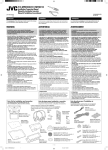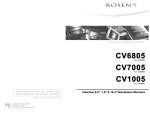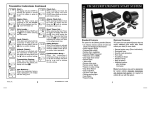Download 3Com X3 Owner's Manual
Transcript
Installation and Owner’s Manual Model: X3 For Technical Assistance, please call (800) 638-3600, or visit www.magnadyne.com This device complies with part 15 of the FCC rules. Operation is subject to the following two conditions: (1) This device may not cause harmful interference; and (2) This device must accept any interference received, including interference that may cause undesired operation. Note: The manufacturer is not responsible for any radio or TV interference caused by unauthorized modifications to this equipment. Such modifications could void the user’s authority to operate the equipment. Table of Contents Component Installation . . . . . . . . . . . . . . . . . . . . . . . . . . . . . . . . . . . . . . . . . . . . . . . . . . . . . . . . . . . . . . . . Wiring White 12-Pin Main Harness . . . . . . . . . . . . . . . . . . . . . . . . . . . . . . . . . . . . . . . . . . . . . . . . . . . . . . . . . . . Wiring Harness Quick Reference . . . . . . . . . . . . . . . . . . . . . . . . . . . . . . . . . . . . . . . . . . . . . . . . . . . . . . . Black 3-Pin Door Lock Harness . . . . . . . . . . . . . . . . . . . . . . . . . . . . . . . . . . . . . . . . . . . . . . . . . . . . . . . . Optional Wiring Suggestions . . . . . . . . . . . . . . . . . . . . . . . . . . . . . . . . . . . . . . . . . . . . . . . . . . . . . . . . . . . Programming the Transmitter . . . . . . . . . . . . . . . . . . . . . . . . . . . . . . . . . . . . . . . . . . . . . . . . . . . . . . . . . . . Alarm Feature Programming . . . . . . . . . . . . . . . . . . . . . . . . . . . . . . . . . . . . . . . . . . . . . . . . . . . . . . . . . . . . Shock Sensor Testing and Adjustment . . . . . . . . . . . . . . . . . . . . . . . . . . . . . . . . . . . . . . . . . . . . . . . . . . . . Owners Manual . . . . . . . . . . . . . . . . . . . . . . . . . . . . . . . . . . . . . . . . . . . . . . . . . . . . . . . . . . . . . . . . . . . . . . 2 2-5 3 6 5-6 6-7 7-8 9 9-12 Component Installation Mounting the Control Module: Find a suitable location to secure the alarm control module within the passenger’s compartment of the vehicle. Never mount the alarm control module in the engine compartment or in the trunk. In addition, never mount the alarm control module in the direct path of the heater. Secure the alarm control module by using wire ties or drill two 1/8" holes and secure the module to the frame of the vehicle with the screws provided. Valet Switch Select a mounting location for the switch that is easily accessible to the driver of the vehicle. The switch does not have to be concealed. However, concealing the switch is always recommended, as this provides an even higher level of security to the vehicle. Mount the valet switch in a hidden but accessible location. Route the valet switch wires to the control module. LED Status Indicator The LED status indicator should be mounted in a highly visible area. Leave at least 6mm of space behind the mounting location for LED housing. Once a suitable location is chosen, drill a 1/4" hole. Run the LED wires through the hole then press the 2-pin LED housing into the place. Route the LED wires to the control module. Antenna Wire For maximum possible range, keep the antenna wire away from the alarm harnesses. Stretch out the antenna in another direction and keep it as straight as possible. Do not connect the antenna wire to ground. Do not lengthen or shorten the antenna wire. Do not coil or wind the antenna wire around another harness. Wiring HC4: White 12-Pin Main Harness The main wire harness contains 11 wires which all have a specific purpose. Follow the wiring recommendations enclosed for each wire. Wires not used should be released from the harness connector or taped off to prevent accidental shorting. Yellow Wire: +12VDC Ignition Input Connect the Yellow wire to a +12 volt wire that is switched on and off by the ignition key. The correct wire will indicate +12 volts when the ignition key is in the on and start positions. Do not connect the yellow wire to the “ACC” wire coming from the ignition switch. Green Wire: (-) Common Door Pin Input The green wire connects to the common wire of the vehicle that switches on the dome light. Normally this wire is located at one of the door jamb switches. For some vehicles it may be necessary to connect the green wire directly to the switched turn on wire at the dome light. The green wire connects to negative switched circuits only. Blue Wire: (-) Hood / Trunk / Auxiliary Trigger Input The blue wire is an instant grounding trigger input for optional hood/trunk grounded pin switches or any electronic sensor. 2 Wiring Harness Quick Reference HC4 12-Pin Main Harness Yellow +12VDC Ignition Input Green (-) Common Door Pin Input Blue (-) Hood / Trunk / Auxiliary Trigger Input Violet (+) Common Door Pin Input Orange (-) Ground when Armed Output Open No Connection Red/White (-) 300mA Programmable Channel 3 (Trunk) Output Black Chassis Ground Brown (-) Siren Output White/Red (+/-) Parking Light Relay Input Red +12VDC Battery Input White (+/-) Parking Light Relay Output HC3 3-Pin Door Lock Harness Green (-) Lock Open No Connection Blue (-) Unlock Wiring (continued) Violet Wire: (+) Common Door Pin Input The violet wire connects to the common wire of the vehicle that switches on the dome light. Normally this wire is located at one of the door jamb switches. For some vehicles it may be necessary to connect the violet wire directly to the switched turn on wire at the dome light. The violet wire connects to positive switched circuits only. Orange Wire: (-) Ground when Armed Output The orange wire is typically connected to an optional starter disable relay as shown. SPDT 30A Relay (Not Supplied) Orange Wire (Ground when Armed Alarm Output) 87 87a 85 86 30 "OFF" "ACC" "IGN" Starter "START" Black Cut Black 3 Wiring (continued) Red/White Wire: (-) 300mA Programmable Channel 3 Output (Default Trunk Release) The Red/White wire is typically used to release the power trunk by remote. An additional relay is usually required as shown in the diagram below. This wire can also be programmed for Domelight Supervision Control or 2nd unlock function (See Alarm Feature Programming to change the setting) Output to Power Trunk Switch 87 Red/White Wire (SPST ALA984H Relay Not Supplied) To Constant +12 Volts 86 30 85 Input to Relay (+ or -) Black Wire: Chassis Ground This is main ground connection of the alarm module. Make this connection to a solid section of the vehicle chassis. Do not connect this wire to any existing ground wires supplied by the factory wire loom, make the connection to the vehicle’s chassis directly. Vacant Socket: No Connection Brown Wire: (-) Siren Output Connect the brown wire to the Negative wire from an electronic siren (Siren Supplied). Connect t the remaining wire from the siren to +12 volt. (Battery +) The Brown wire can also be programmed for (-) horn honk output. (See Alarm Feature Programming to change the setting) White/Red Wire: (+/-) Parking Light Relay Input The white/red wire is the input to the flashing parking light relay. The connection of the white/red wire will determine the output polarity of the flashing parking light relay. Connect the white/red wire to (+) battery to have (+) output from the relay or connect the white/red wire to chassis ground to have ground output from the relay. Red Wire: +12VDC Battery Input Connect the Red wire directly to the (+) battery post for best operation of the alarm system. White Wire: (+/-) Parking Light Relay Output Connect the white wire to the parking light wire coming from the headlight switch. Do not connect the white wire to the dashboard lighting dimmer switch – Damage to the dimmer will result. Use a volt meter to test the connection point before connecting the white wire. While checking, rotate the dimmer switch to make sure you do not have the dimmer lead. The limitation of the white wire is 10 Amp max. Do not exceed this limit or damage to the alarm and parking light relay will result. Headlight Switch White Wire 4 Piggyback Connection Parking Lights Only Wiring (continued) HC3: Black 3-Pin Door Lock Harness Blue Wire: (-) Door Unlock Control Connect the Blue wire to the unlock wire from the door lock switch. If the door locking system is not a (-) trigger system, additional relays will be required. Green Wire: (-) Door Lock Control Connect the Green wire to the lock wire from the door lock switch. f the door locking system is not a (-) trigger system, additional relays will be required. 3 Wire Ground Trigger Door Lock System Green Wire: Connect to Lock Blue Wire: Connect to Unlock Black 3-Pin Mini Connector (-) Lock Out Lock Control Switch Ground Input To Door Lock Control Relays (-) Unlock Out P1: LED Status Indicator P2: Valet Switch Optional Wiring Diagrams Red/White Wire: (When programmed for (-) 2nd Unlock Output) When Programmed for this function, the Red/White wire provides a second (-) unlock output to unlock the passenger’s doors. Use the “Blue Wire” on the Black 3 pin connector to unlock the drivers door. Unlock Driver's Door First for 3-Wire Negative Door Lock Systems Green Wire Blue Wire 87 Red/White Wire 87A 85 Driver's Door Switch Lock 86 30 Unlock Lock To +12V or Ground Driver's Door Unlock Wire +12V ALA984H Relay Cut Unlock Door Lock Relay Control Module Passenger's Door Switch To +12V or Ground Passenger's Door 5 Optional Wiring Diagrams Red/White Wire: (When programmed for (-) Domelight Supervision Output) When Programmed for this function, the Red/White wire provides a (-) output to turn on the vehicles interior light when the alarm has been disarmed. The domelight will stay on for 30 seconds unless the ignition key is on. Output to Dome Light (+ or -) 87 Red/White Wire (SPST ALA984H Relay Not Supplied) To Constant +12 Volts 86 85 30 Input to Relay (+ or -) Brown Wire: (When programmed for (-) Horn Output) When Programmed for this function, the Brown wire provides a (-) output to use the vehicles horn as the primary sounding device. Locate the horn button wire at the base of the steering column. Note: Some vehicles will require an additional relay. To Horn Fuse 87 Brown Wire To +12V 87a 85 86 30 +12V or Ground Depending on System Requirements Programming the Transmitter Programming the Remote Transmitter Note: This mode will only retain the last 4 remote transmitters programmed. If the transmitter memory is exceeded, the security system will start deleting transmitters from memory in chronological order. Step 1 Step 2 3X With the ignition switch in the OFF position, turn the key On 6 Before 15 seconds has passed, push and release the valet switch 3 times. THe siren will emit 1 long + 1 short chirp. You are now in “Transmitter Programming” mode. Programming the Transmitter Step 3 Step 5: Exit Program Mode Step 4 Press the “Lock” button on the first transmitter until you hear a confirmation chirp/beep. The transmitter is now coded into the system. Repeat for each additional transmitter. When finished, turn Off the ignition key or wait for 15 seconds to get out of transmitter programming mode. You will hear 3 long chirps/beeps. You are out of the transmitter programming mode. Alarm Feature Programming Examine the feature chart enclosed and decide which feature will get changed. Circling the feature to be changed will make the programming process much easier to perform. Step 2 Step 1 + 3X With the ignition switch in the OFF position, turn the key On-Off Step 3 3X Within 10 seconds, push and release the valet switch 3 times. The siren/horn will emit 1 long chirp or beep. Push and release the valet switch 3 more times. The siren/horn will emit 1 long chirp or beep. You are now in “Alarm Feature Programming” mode. 1. Press the valet switch the number of times required to access the feature that needs adjusting. 2. Press the indicated transmitter button and listen for the chirp sequence to set the feature. Example: - Complete steps 1,2 and 3 to enter feature program mode - Push the valet switch 2 times, (Selects Manual/Automatic arm programming) the siren will chirp 2 times and the LED will flash 2 times. - Change the feature to “Automatic Arming” by Pressing the button on the transmitter. The siren/horn will chirp 2 times. 7 Alarm Feature Programming (continued) Press TX Button Press LED Flash/ Valet Chirp Switch Press TX Button One Chirp (Default Setting) Press TX Button Two Chirps Press TX Button Three Chirps 1 1 Chirps “On” Chirps “Off” 2 2 Manual Arming Automatic Arming without Door Locking 3 3 Ignition On/Off with Door Lock/Unlock Ignition On/Off without Door Lock/Unlock 4 4 Auto Rearm “Off” Auto Rearm “On” .8 Sec Door Lock/ Unlock Output Car-Jacking “Off” 3.5 Sec Door Lock/ Unlock Output .8 Sec Double Unlock Output Automatic Arming with Door Locks 5 5 6 6 Manual Car-Jack “On” Automatic Car-Jack “On” 7 7 HC4 Red/White Wire (-) Channel 3 Output HC4 Red/White Wire (-) Domelight Output HC4 Red/White Wire (-) 2nd Unlock Output 8 8 Trunk Release Disarm On Trunk Release Disarm Off 9 9 Alarm/Keyless Entry Mode 10 10 HC4 Brown Wire Siren Output 11 11 Instant Door Ajar Warning Door Ajar Warning with 45 Second Delay 12 12 Standard Horn Pulse Output “SOS” Type S-S-S - L-L-L - S-S-S Keyless Entry Only Mode (No Alarm Functions) (No Carjacking Functions) HC4 Brown Wire Pulsed Siren Output HC4 Brown Wire Horn Output S-L-S-L 4-chirp S-S-S-L 5-chirp S-M-L-S-M-L 6-chirp SS - L - S-S Turn On the Ignition 3 long chirps will confirm exit of the programming mode. Step 4: Exit Program Mode Note: Waiting 15 seconds after the last command will also cause the system to automatically exit the programming mode. Shock Sensor Testing and Adjustment Step 1 Step 2 3X Turn the ignition switch from the OFF position to the ON position 3 times leaving it in the Off position the third time. 8 Step 3 5X + 1X (Hold) Before 15 seconds has passed, push and release the valet switch 6 times. Hold the button down on the 6th press until 3 short chirp/beeps and 1 long chirp/beep is heard then release it. Press and release the ( ) button for 2 seconds. You will hear 1 long siren/horn chirp. You are now in the “Primary Trigger Shock Sensor Test mode”. Shock Sensor Testing and Adjustment Step 5 Step 6 1. Press and hold the LOCK and UNLOCK buttons together for 2 seconds. You will hear 2 long siren/horn chirp. You are now in the “Pre-warning” trigger Shock Sensor test mode. 2. Follow the procedures in Step 4 to adjust the “Pre-warning”sensitivity. To exit the shock sensor test mode, turn ignition “On” and 3 long chirps will confirm exit of the “Shock Sensor” test mode. Note: 30 seconds of inactivity will force exit of the shock sensor test mode. Step 4 Increase Decrease 1. Press the LOCK button to increase sensitivity by 1 step (1 chirp) 2. Press the UNLOCK button to decrease the sensitivity by 1 step (1 chirp) 3. Rap on the vehicle body panels and glass to achieve the proper setting. Note: If you hear 2 chirps while making an adjustment, you have reached the max setting. Owners Manual A. Transmitter Operation Lock/ Arm Car-Finder B. Alarm Status Indicators Un-Lock/ Disarm 2nd System CH#3 (Trunk) Panic LED Indications LED is off = Alarm is disarmed. LED is flashing normal = Alarm is armed. LED is flashing fast = Automatic Arming Countdown. LED is on (solid) = Valet Mode. LED flashes twice then pauses = Tamper warning, alarm was triggered by an open trunk or hood. LED flashes three times then pauses = Tamper warning, alarm was triggered by an open door. LED flashes four times then pauses = Tamper warning, alarm was triggered by the shock sensor. LED flashes five times then pauses = Tamper warning, alarm was triggered by voltage from the ignition switch turning on. Chirp Indications One siren chirp = Security system is armed. Two siren chirps = Security is disarmed. Four chirps = Tamper disarm warning, alarm was previously triggered. Two sets of two chirps = Stage 1 of progressive car finder Two sets of three chirps = Stage 2 of progressive car finder Six chirps = Stage 3 of progressive car finder Parking Light Indications Parking lights flash one time upon arming = Security system is armed. Parking lights flash two times upon disarming = Security system is disarmed. Parking lights flash three times upon disarming = Tamper disarm warning, alarm was previously triggered. Parking lights flash three times while armed = Stage 1 and 2 of progressive car finder Parking lights flash six times while armed = Stage 3 of progressive car finder 9 Owners Manual (Continued) Button Function: Transmitter Button + Action System Function / Remark Press and Release Arm/Lock Doors Press Twice Arm/Lock Doors + Delete Shock Sensor (2nd Long Beep) Press and Release Progressive Car Finder (Functions 30 Seconds After Armed) Press and Release Disarm/Un-Lock Doors Press and Hold for 1.5 Seconds Channel 3 Activation (Release Trunk as Default) Press Both Buttons Together Silent Arm/Disarm (Ignition Key is Off) Press and Hold Both Buttons for 1 Second Activate Car-Jacking (Ignition Key Must be On) Press and Hold for 3 Seconds Press and Hold for Panic Mode On Press and Release for Panic Mode Off Press and Release Activate 2nd System operation C. Dual-Zone Shock Sensor 1. Light impacts to the vehicle will cause a pre-warning (warn-away) chirp from the siren or horn. These light impacts will not set the alarm into full trigger even if they are repetitive. 2. Hard impacts to the vehicle will bypass the pre-warning indicator and activate a full alarm trigger. D. Manual Arming “Lock” 1. Press the “Lock” button on the transmitter. 2. The siren will chirp once and the parking light will flash once indicating that the system is now armed. The vehicle’s doors will lock upon arming if door lock control has been installed. Silent Arming/Disarming: Press the “Lock” and “Unlock” button together on the transmitter to arm or disarm you security system. No chirp sound will be heard, arm/disarm confirmation will be through the vehicles parking lights only. E. Automatic Arming This X3 security system is equipped with an optional Automatic Arming feature, which allows the security system to arm 30 seconds after the last door is closed. Operation: 1. Turn the ignition to the “Off” position and exit the vehicle. 2. After all entrances are closed the security system’s LED will flash fast for 30 seconds. If you reopen any protected entrance, the security system LED will stop flashing. It will begin flashing again once all the protected vehicle’s entrances are closed. 3. After the 30-second timer has elapsed, the security system will automatically “Arm”. The siren will chirp one time and the parking lights will flash one time. Passive Door Locking: If the “Automatic Arming with Door Locks” feature has been programmed on, The vehicle doors will automatically lock after the automatic arming cycle has been completed. (see Feature No. 2 on programming chart) 10 Owners Manual (Continued) F. Manual Disarming “Unlock” 1. Press the “Unlock” button on the transmitter. 2. The siren will chirp twice and parking lights will flash twice indicating that the security system is now disarmed. The vehicle doors will unlock disarming when interfaced with the security system. Tamper Disarming: If alarm is triggered upon disarming the system, the siren chips 4 times and the parking lights flash 3 times. Automatic Rearm: (see feature No. 5 on programming chart) If this feature is selected, the security system will automatically rearm itself 60 seconds after disarming with remote transmitter. Automatic rearm will cancel if any door is opened before the 60 seconds timer has elapsed. G. Valet Mode The valet switch allows you to temporarily bypass all alarm functions, eliminating the need to give your transmitter to parking attendants or garage mechanics. When the system is in valet mode, all alarm function are bypassed, however the remote panic feature and remote door locks will remain operational. Enter Valet Mode: 1. Turn the ignition to the “On” position. 2. Push and hold valet switch for 2 seconds until the LED turns on. The LED will remain on as long as the system is in the Valet Mode. Exit Valet Mode: 1. Return to normal operation, turn ignition “On”. 2. Push and hold the valet switch for 2 seconds, the LED will turn off to indicate the system is exiting the valet mode. H. Panic Function The transmitter can be used as a remote panic switch to manually trigger the alarm in case of emergency. 1. Press and hold the “Star” button on the transmitter for 3 seconds. The alarm will immediately sound. 2. To stop the panic alarm, press and release any button on the transmitter, the panic mode will be turned off immediately. 3. If the button is not pressed, the panic alarm will automatically stop after 60 seconds. I. 60 Second Rearming If your security system has become triggered, the siren will sound for 60 seconds and then stop and reset to a fully armed condition. Note: If the alarm system has been triggered from the following inputs (Trunk/Shock sensor - Ignition key on or Door open), and an input remains in a triggered state (a door left open for example) your security system will remain triggered for three 60 second cycles then it will fully rearm and excluding the input that triggered it . When the excluded trigger is corrected (the door is closed for example) the entrance will reset the door input trigger within 3 seconds. J. Progressive Car Finder Use your remote control to locate your vehicle in a crowded parking lot or structure. Note: The alarm system must be armed for more than 30 seconds before the car finder feature will operate. A. Press the LOCK button on the transmitter. The siren or horn will blast two times and then blast again two more times. The parking lights will flash three times with each blast. B. Press the LOCK button on the transmitter again within 30 seconds. The siren or horn will blast three times and then blast again three more times. The parking lights will flash three times with each blast. C. Press the LOCK button on the transmitter again within 30 seconds. The siren or horn will blast six times. The parking lights will flash six times with each blast. 11 K. Anti Car-Jacking (Manual Activation) Warning: If you don’t need this alarm system’s car-jacking function to be “On”, set it to “Off”. The default car-jacking setting is “Off” (see Feature No. 6 on programming chart). Pressing and holding the “Lock” and “Unlock” button on the transmitter for 1 second while the vehicle’s ignition is “On” will trigger the car-jacking. The parking lights will turn on for 1.5 seconds to indicate carjacking is activated. 1. 60 seconds after the system has been triggered, the siren starts alarming and the parking lights start flashing. 2. 90 seconds after the system has been triggered. A. The siren will still be sounding and the parking light flashing and, B. The starter disable will activate to prevent the vehicle from being restarted, C. It will remain active until the vehicle’s battery power is exhausted. L. Anti Car-Jacking (Automatic Activation) Warning 1: If you don’t need this alarm system’s car-jacking function to be “On”, set it to “Off”. The default car-jacking setting is “Off” (see Feature No. 6 on programming chart). Warning 2: When this feature is programmed for “Automatic Mode” operation, the car-jacking feature is armed at all times when the ignition key is on. Opening any protected entrance while the vehicle’s ignition is “On” will trigger the car-jacking system.. The parking lights will turn on for 1.5 seconds to indicate carjacking is activated. 1. 60 seconds after the system has been triggered, the siren starts alarming and the parking lights start flashing. 2. 90 seconds after the system has been triggered. A. The siren will still be sounding and the parking light flashing and, B. The starter disable will activate to prevent the vehicle from being restarted, C. It will remain active until the vehicle’s battery power is exhausted. Override the System to Turn Off Car-Jacking: Turn the ignition switch from “Off” to “On”, and within 10 seconds push valet switch, the siren will stop and the system will disarm. © Copyright 2008-2009 Magnadyne Corporation X3-IMUM 7-24-08 Rev. A


























